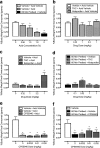Dissociable effects of the cannabinoid receptor agonists Δ9-tetrahydrocannabinol and CP55940 on pain-stimulated versus pain-depressed behavior in rats
- PMID: 22892341
- PMCID: PMC3477211
- DOI: 10.1124/jpet.112.197780
Dissociable effects of the cannabinoid receptor agonists Δ9-tetrahydrocannabinol and CP55940 on pain-stimulated versus pain-depressed behavior in rats
Abstract
Cannabinoid receptor agonists produce reliable antinociception in most preclinical pain assays but have inconsistent analgesic efficacy in humans. This disparity suggests that conventional preclinical assays of nociception are not sufficient for the prediction of cannabinoid effects related to clinical analgesia. To extend the range of preclinical cannabinoid assessment, this study compared the effects of the marijuana constituent and low-efficacy cannabinoid agonist Δ9-tetrahydrocannabinol (THC) and the high-efficacy synthetic cannabinoid agonist 3-(2-hydroxy-4-(1,1-dimethylheptyl)phenyl)-4-(3-hydroxypropyl)cyclohexanol (CP55940) in assays of pain-stimulated and pain-depressed behavior. Intraperitoneal injection of dilute lactic acid (1.8% in 1 ml/kg) stimulated a stretching response or depressed intracranial self-stimulation (ICSS) in separate groups of male Sprague-Dawley rats. THC (0.1-10 mg/kg) and CP55940 (0.0032-0.32 mg/kg) dose-dependently blocked acid- stimulated stretching but only exacerbated acid-induced depression of ICSS at doses that also decreased control ICSS in the absence of a noxious stimulus. Repeated THC produced tolerance to sedative rate-decreasing effects of THC on control ICSS in the absence of the noxious stimulus but failed to unmask antinociception in the presence of the noxious stimulus. THC and CP55940 also failed to block pain-related depression of feeding in rats, although THC did attenuate satiation-related depression of feeding. In contrast to the effects of the cannabinoid agonists, the clinically effective analgesic and nonsteroidal anti-inflammatory drug ketoprofen (1 mg/kg) blocked acid-stimulated stretching and acid-induced depression of both ICSS and feeding. The poor efficacy of THC and CP55940 to block acute pain-related depression of behavior in rats agrees with the poor efficacy of cannabinoids to treat acute pain in humans.
Figures








Similar articles
-
Effects of μ-opioid receptor agonists in assays of acute pain-stimulated and pain-depressed behavior in male rats: role of μ-agonist efficacy and noxious stimulus intensity.J Pharmacol Exp Ther. 2015 Feb;352(2):208-17. doi: 10.1124/jpet.114.219873. Epub 2014 Nov 18. J Pharmacol Exp Ther. 2015. PMID: 25406170 Free PMC article.
-
Relief of Pain-Depressed Behavior in Rats by Activation of D1-Like Dopamine Receptors.J Pharmacol Exp Ther. 2017 Jul;362(1):14-23. doi: 10.1124/jpet.117.240796. Epub 2017 Apr 14. J Pharmacol Exp Ther. 2017. PMID: 28411257 Free PMC article.
-
Effects of nicotinic acetylcholine receptor agonists in assays of acute pain-stimulated and pain-depressed behaviors in rats.J Pharmacol Exp Ther. 2015 Nov;355(2):341-50. doi: 10.1124/jpet.115.226803. J Pharmacol Exp Ther. 2015. PMID: 26359313 Free PMC article.
-
Current evidence of cannabinoid-based analgesia obtained in preclinical and human experimental settings.Eur J Pain. 2018 Mar;22(3):471-484. doi: 10.1002/ejp.1148. Epub 2017 Nov 21. Eur J Pain. 2018. PMID: 29160600 Review.
-
Cannabis use and the development of tolerance: a systematic review of human evidence.Neurosci Biobehav Rev. 2018 Oct;93:1-25. doi: 10.1016/j.neubiorev.2018.07.014. Epub 2018 Jul 26. Neurosci Biobehav Rev. 2018. PMID: 30056176
Cited by
-
Δ9-tetrahydrocannabinol and endocannabinoid degradative enzyme inhibitors attenuate intracranial self-stimulation in mice.J Pharmacol Exp Ther. 2015 Feb;352(2):195-207. doi: 10.1124/jpet.114.218677. Epub 2014 Nov 14. J Pharmacol Exp Ther. 2015. PMID: 25398241 Free PMC article.
-
The Development of Cannabinoids as Therapeutic Agents in the United States.Pharmacol Rev. 2024 Aug 15;76(5):915-955. doi: 10.1124/pharmrev.123.001121. Pharmacol Rev. 2024. PMID: 38849155 Free PMC article. Review.
-
Effects of the α2/α3-subtype-selective GABAA receptor positive allosteric modulator KRM-II-81 on pain-depressed behavior in rats: comparison with ketorolac and diazepam.Behav Pharmacol. 2019 Aug;30(5):452-461. doi: 10.1097/FBP.0000000000000464. Behav Pharmacol. 2019. PMID: 30640180 Free PMC article.
-
Effects of the fatty acid amide hydrolase inhibitor URB597 on pain-stimulated and pain-depressed behavior in rats.Behav Pharmacol. 2014 Apr;25(2):119-29. doi: 10.1097/FBP.0000000000000023. Behav Pharmacol. 2014. PMID: 24583930 Free PMC article.
-
Neuropharmacology of New Psychoactive Substances (NPS): Focus on the Rewarding and Reinforcing Properties of Cannabimimetics and Amphetamine-Like Stimulants.Front Neurosci. 2016 Apr 19;10:153. doi: 10.3389/fnins.2016.00153. eCollection 2016. Front Neurosci. 2016. PMID: 27147945 Free PMC article. Review.
References
-
- Anikwue R, Huffman JW, Martin ZL, Welch SP. (2002) Decrease in efficacy and potency of nonsteroidal anti-inflammatory drugs by chronic Δ9-tetrahydrocannabinol administration. J Pharmacol Exp Ther 303:340–346 - PubMed
-
- Beaulieu P. (2006) Effects of nabilone, a synthetic cannabinoid, on postoperative pain. Can J Anaesth 53:769–775 - PubMed
-
- Blackburn-Munro G. (2004) Pain-like behaviours in animals–how human are they? Trends Pharmacol Sci 25:299–305 - PubMed
Publication types
MeSH terms
Substances
Grants and funding
LinkOut - more resources
Full Text Sources
Medical

